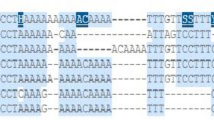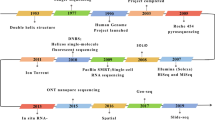Abstract
To derive a more precise estimation of the relationship between miR-149 C>T polymorphism and cancer risk, a meta-analysis was performed. A total of 8 studies including 4,677 cases and 4,830 controls were involved in this meta-analysis. Overall, no significantly elevated cancer risk was associated with miR-149 T allele when all studies were pooled into the meta-analysis (CT vs. CC: OR = 0.977, 95 % CI = 0.882–1.082; TT vs. CC: OR = 0.985, 95 % CI = 0.857–1.132; dominant model: OR = 0.984, 95 % CI = 0.893–1.084; recessive model: OR = 1.026, 95 % CI = 0.931–1.132). In the subgroup analysis by ethnicity or study design, no significantly increased risks were found under all models. When stratified by cancer type, there were no significant cancer risk changes for lung cancer, breast cancer or colorectal cancer when miR-149 T allele was included. In conclusion, this meta-analysis suggests that the miR-149 C>T polymorphism may not contribute to cancer susceptibility.
Similar content being viewed by others
References
Bentwich I, Avniel A, Karov Y et al (2005) Identification of hundreds of conserved and nonconserved human microRNAs. Nat Genet 37:766–770
Griffiths-Jones S, Grocock RJ, van Dongen S, Bateman A, Enright AJ (2006) miRBase: microRNA sequences, targets and gene nomenclature. Nucleic Acids Res 34:D140–D144
Wienholds E, Plasterk RH (2005) MicroRNA function in animal development. FEBS Lett 579:5911–5922
Macfarlane LA, Murphy PR (2010) MicroRNA: biogenesis, function and role in cancer. Curr Genomics 11:537–561
He L, Hannon GJ (2004) MicroRNAs: small RNAs with a big role in gene regulation. Nat Rev Genet 5:522–531
Paranjape T, Slack FJ, Weidhaas JB (2009) MicroRNAs: tools for cancer diagnostics. Gut 58:1546–1554
Saunders MA, Liang H, Li WH (2007) Human polymorphism at microRNAs and microRNA target sites. Proc Natl Acad Sci USA 104:3300–3305
Calin GA, Dumitru CD, Shimizu M et al (2002) Frequent deletions and down-regulation of micro-RNA genes miR15 and miR16 at 13q14 in chronic lymphocytic leukemia. Proc Natl Acad Sci USA 99:15524–15529
Thakkinstian A, McElduff P, D’Este C, Duffy D, Attia J (2005) A method for meta-analysis of molecular association studies. Stat Med 24:1291–1306
Rohlfs RV, Weir BS (2008) Distributions of Hardy–Weinberg equilibrium test statistics. Genetics 180:1609–1616
Higgins JP, Thompson SG, Deeks JJ, Altman DG (2003) Measuring inconsistency in meta-analyses. Br Med J 327:557–560
Tian T, Shu Y, Chen J et al (2009) A functional genetic variant in microRNA-196a2 is associated with increased susceptibility of lung cancer in Chinese. Cancer Epidemiol Biomarkers Prev 18:1183–1187
Hu Z, Liang J, Wang Z et al (2009) Common genetic variants in pre-microRNAs were associated with increased risk of breast cancer in Chinese women. Hum Mutat 30:79–84
Liu Z, Li G, Wei S et al (2010) Genetic variants in selected pre-microRNA genes and the risk of squamous cell carcinoma of the head and neck. Cancer 116:4753–4760
Vinci S, Gelmini S, Pratesi N et al (2011) Genetic variants in miR-146a, miR-149, miR-196a2, miR-499 and their influence on relative expression in lung cancers. Clin Chem Lab Med. doi:10.1515/CCLM.2011.708
Min KT, Kim JW, Jeon YJ et al (2011) Association of the miR-146aC>G, 149C>T, 196a2C>T, and 499A>G polymorphisms with colorectal cancer in the Korean population. Mol Carcinog. doi:10.1002/mc.21849
Zhang MW, Jin MJ, Yu YX et al (2011) Associations of lifestyle-related factors, hsa-miR-149 and hsa-miR-605 gene polymorphisms with gastrointestinal cancer risk. Mol Carcinog. doi:10.1002/mc.20863
Zhang M, Jin M, Yu Y et al (2012) Associations of miRNA polymorphisms and female physiological characteristics with breast cancer risk in Chinese population. Eur J Cancer Care (Engl) 21:274–280
Wu M, Jolicoeur N, Li Z et al (2008) Genetic variations of microRNAs in human cancer and their effects on the expression of miRNAs. Carcinogenesis 29:1710–1716
Calin GA, Ferracin M, Cimmino A et al (2005) A microRNA signature associated with prognosis and progression in chronic lymphocytic leukemia. N Engl J Med 353:1793–1801
Yang H, Dinney CP, Ye Y, Zhu Y, Grossman HB, Wu X (2008) Evaluation of genetic variants in microRNA-related genes and risk of bladder cancer. Cancer Res 68:2530–2537
Clague J, Lippman SM, Yang H et al (2010) Genetic variation in microRNA genes and risk of oral premalignant lesions. Mol Carcinog 49:183–189
Ye Y, Wang KK, Gu J et al (2008) Genetic variations in microRNA-related genes are novel susceptibility loci for esophageal cancer risk. Cancer Prev Res (Phila) 1:460–469
Acknowledgments
This research was supported by grants from the National Natural Science Foundation of China (81101499), Shanghai Natural Science Foundation (11ZR1407600), and Fudan University Science Foundation for Young Scholars (09FQ76).
Conflict of interest
None.
Author information
Authors and Affiliations
Corresponding author
Additional information
Jian Zhang and Yan-fei Liu contributed equally to this study.
Electronic supplementary material
Below is the link to the electronic supplementary material.

11033_2012_1735_MOESM1_ESM.jpg
Supplementary files. Figure 1 Forest plots for the association between miR-149 C/T (rs2292832) polymorphism and cancer risk. a CT vs. CC analysis. b TT vs. CC analysis. c dominant model analysis. d recessive model analysis. (JPEG 229 kb)
Rights and permissions
About this article
Cite this article
Zhang, J., Liu, Yf. & Gan, Y. Lack of association between miR-149 C>T polymorphism and cancer susceptibility: a meta-analysis based on 4,677 cases and 4,830 controls. Mol Biol Rep 39, 8749–8753 (2012). https://doi.org/10.1007/s11033-012-1735-4
Received:
Accepted:
Published:
Issue Date:
DOI: https://doi.org/10.1007/s11033-012-1735-4




